#Murex Seashells
Text

Murex. Art by Bethany van Rijswijk, from the Seashell Oracle.
Power, Luxury, Effort
8 notes
·
View notes
Text
Animal Crossing Fish - Explained #237c
Brought to you by a marine biologist and gastropods (who are also weird)...
CLICK HERE FOR THE AC FISH EXPLAINED MASTERPOST!
Here's the last installment of the ACPC shells miniseries. The diversity of mollusks that AC shows is pretty great, though I wish some of these weirdos made it into the mainline games. Mollusks can be broken down into three major Classes the everyday person would recognize (there are others, but these are the well known ones) - Bivalvia, Gastropoda, and Cephalopoda. Today we're looking at the Gastropods, the snails and slugs and the most numerous of the mollusks at a hefty 70,000 species. Let's get into it~
Strawberry Top Snail
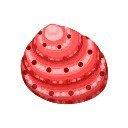
In every way, the shell of the Strawberry Top Snail (Clanculus puniceus; STS from now on) is so reminiscent of a goddamn strawberry and I can't get over it. It's so bright and vibrant. The STS is native to the Western edge of the Indian Ocean near Madagascar, South Africa, and Mozambique. Top snails are named so because they look like an old-timey spinning toy. They are generally herbivores, scraping algae off rocks with their radula, a spiky tongue-like appendage in the mouth of Gastropods that lets them scrape food, whether that be plant, meat, or detritus. The STS is an herbivore and can generally be found in the intertidal zone stuck to a rock eating algae. What a life!
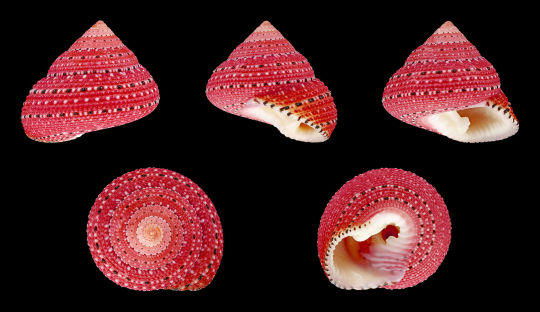
By H. Zell - Own work, CC BY 3.0, https://commons.wikimedia.org/w/index.php?curid=41628798
------------------------------------------------------------------------------
Anatomical Murex
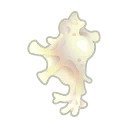
If you think this shell is odd, I've got news for you - there are about 1,600 species within this animal's Family, Muricidae with growth like this. Most snails in this family have some of the most complicated yet beautiful shells with strange protrusions, spikes, bumps, and ribbing. These protrusions are called varices (singly: varix), and they are extremely important in identifying the species that have them. These snails are texture gods. The Anatomical Murex (Homalocantha anatomica), also called Pele's Murex, often has 5-6 varices per whorl in its shell. They can be found in the Red Sea, throughout the Western Pacific to Hawaii.
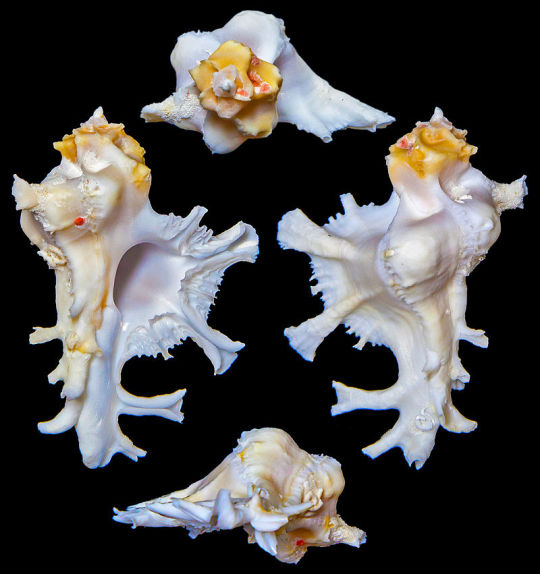
By C. CHEN - Own work, CC BY-SA 3.0, https://commons.wikimedia.org/w/index.php?curid=26698151
------------------------------------------------------------------------------
Guildfordia Yoka

I honestly couldn't tell you why ACPC decided to call this by it's scientific binomial, but such is the mystery of AC. It's common name is the Yoka Star Turban (Guildfordia yoka; YST from now on), and it is a type of turban shell snail. It belongs in the Order Trochida along with the Strawberry above. That relation to top snails is more obvious in the picture below. The YST is a tropical species of the Indo-Pacific near Japan down to The Philippines.
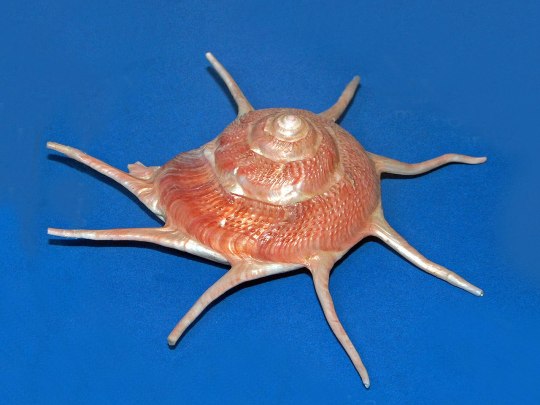
By Hectonichus - Own work, CC BY-SA 4.0, https://commons.wikimedia.org/w/index.php?curid=61829033
And there you have it! Fascinating snails, yeah?
#snails#sea snails#yoka star turban shell#anatomical murex#strawberry top snail#gastropods#seashells#marine biology#animals#animal crossing#animal crossing pocket camp#acpc#science in video games#animal crossing fish explained
11 notes
·
View notes
Text
❌ Curse Correspondences ❌
Crystals:
Agate - for use on a target who has entered a space uninvited, i.e. someone breaking into your home or vehicle
Alexandrite - causes obsession and delusions
Amethyst - causes sensitivity and self-destruction
Astrophyllite - causes those who have died at the hands of another to torment the target from the grave
Diamond - causes blindness, confusion, and disorientation
Diopside - lowers inhibitions and causes secrets to be revealed
Emerald - causes greed, selfishness, and isolation
Flint - causes conflicts
Garnet - leeches energy from a target
Kunzite - induces vulnerability
Kyanite - used to infiltrate a target’s mind
Meteorite - used as a catalyst in baneful magic
Obsidian - used for general aggressive magic
Onyx - causes nightmares and mental torment, and is used to break up relationships
Opal - used to store negative energy, and then to be given to a target
Ruby - used to focus your intent on a target
Colors:
Black - law, justice, manifestation, sorrow
Red - force, energy, confrontation, jealousy, anger
Greenish Yellow - strife, discord, illness, conflict, jealousy, greed
Magenta - catalyst
Botanicals:
Ague Weed - confusion
Angelica Root - misery, strife, distress, discord
Asafoetida - drives enemies away
Bayberry - depression
Bindweed - binding
Blackberry Root - distress
Black Salt - misery, strife, distress, discord
Bladderwrack - illness
Bloodroot - substitute for blood
Blueberry - confusion, strife
Boneset - distress, confusion
Cayenne Pepper - anxiety
Chicory - discord
Chili Powder - discord, misery, strife
Cinquefoil - discomfort
Clove - stopping gossip
Cramp Bark - pain, illness
Dogbane - deception
Dragon’s Blood - destruction, strife, misery
Hemlock - discord, sadness
Henbane - illness, discord, melancholy
Jezebel Root - wickedness, ending relationships, punishing unfaithful lovers
Knot Weed - binding
Lemon - sourness, bitterness
Lemon Verbena - a boost of power, ending relationships
Lime - sourness, bitterness
Lobelia - discord
Mace - misery, strife
Mandrake - misery, strife
Mistletoe - isolation, confusion
Mullein - spirit work, nightmares
Mustard Seed - strife, discord
Myrrh - a boost of power
Nightshade (Belladonna) - discord, illness
Onion - strife
Patchouli - illness
Poke Root - confusion, discord
Poppy Seed - discord
Rue - misery
Safflower - destruction
Spanish Moss - bad luck
Slippery Elm - ending relationships
Stinging Nettle - jealousy, envy, discomfort
Sumac - bad luck
Tobacco - a substitute for any baneful herb
Tormentil - distress, harm, discord
Vetiver - silence
Wormwood (Absinthe) - misery, strife
Yew - spirit work
Yohimbe Bark - impotency
Planets:
Mars - power, force, energy, war, conflict, jealousy
Saturn - law, justice, chaos, revenge
Neptune - confusion, illusion, chaos
Pluto - death, mystery, crisis
Lunar Phases:
Waning - binding, banishing
Dark - destruction, banishing, justice
Black - power, manifestation
Taglocks:
Drawings
Photos
The target’s name written on paper
The target’s signature
An item that belongs to the target
Other Ingredients:
Cigarette butts
Broken glass
Razorblades
Vinegar
Lemon/lime juice
Alcohol
Bones
Needles
Nails
Thorns
Shark teeth
Catfish spines
Murex seashells
Flying Devil Oil
Dead insects
Black sand
Charcoal
Disclaimer: I do not condone the unethical practice of collecting or harvesting animal parts, or forcefully obtaining taglocks. This is just a list of theoretical correspondences and I am not responsible for the actions of others.
© 𝟸𝟶𝟸𝟺 𝙰𝙳-𝙲𝙰𝙴𝙻𝙴𝚂𝚃𝙸𝙰
150 notes
·
View notes
Text

a/n: i love this! i'm gonna do sfw for now cuz i'm low on the nsfw juice but i will try to write a nsfw part in the future so this can act as its own part or a standalone :D also sorry for prematurely posting your request, i got butter fingers
★ elliott & the farmer - the first of many ★
★ elliott had prepped for this day at least a month in advance, he prides himself on his planning skills (except when it comes to his novel but that's beside the point)
★ he wakes the farmer up with breakfast in bed, it's a buffet of eggs, bacon, toast, and so on with his homemade coffee on the side, and completes it with a bombardment of smooches
★ the farmer is a bit groggy and out of it when this happens but eventually reciprocates the kisses with a sleepy smile
★ elliott informs them about the agenda for day, a variety of fun activities for the both of them to do together, such as a private dinner at the saloon and get their painting done by leah
★ the farmer asks elliott about the farm responsibilities and he ensures them that he has it covered
★ cue the farmer peering out the window and seeing penny, jas, vincent, jodi, kent, sam, marnie, and shane working on the farm
★ elliott explains that he convinced penny to do it as an educational experience and she invited the kids' families to help out as a part educational, part family bonding day
★ the farmer, relieved, gestures for elliott to join them back in bed and the two share the breakfast that he prepared
★ after breakfast, elliott takes the farmer down to the beach and to the docks, where the pair enjoy one another's company while their bare feet and legs dangle off the dock's end
★ willy stops by and hands elliott the items he requested earlier in the week, some hemp yarn and a drill
★ noticing the farmer's confusion, he explains that he thought it would be a cute idea to collect seashells on the beach and make one another bracelets, similar to how they worn their mermaid pennant necklaces as a sign of their matrimony
★ the farmer didn't think they could fall even deeper in love with elliott, but time after time, they've been proven wrong and this was just one of the many moments
★ the married couple head off to the beach and begin combing the sands for seashells
★ the farmer and elliott each pick the other person 3 seashells and fasten the shells through the hemp yarn before presenting their counterpart with the finished bracelet
★ elliott's bracelet had a scotch bonnet, a dog head triton, and a partridge tun while the farmer's had a true tulip, an angular trition, and an apple murex
★ they took turns tying the bracelet around their partner’s wrist and exchanged a kiss once they both had their bracelets on
★ next on the agenda was by cindersap woods, where elliott and the farmer found leah with painting supplies in hand and standing by an ornate bench
★ elliott and the farmer listen to leah’s directions, the couple holding one another’s hand while they sat down on the bench as their pose
★ it took all of the farmer’s mental energy not to try and move a muscle, the slightest twitch earning them a side eye from leah
★ it felts like hours went by before the farmer and elliott were allowed to move and get off the bench, their butts sore from sitting for so long
★ leah shows the pair the painting and both of them are in awe at how beautiful it is, the farmer didn’t realize how much of a talented painter leah truly is and compliments her on such an incredible piece of art
★ elliott also shares his praises about the painting and thanks leah for doing this for them
★ leah informs the pair that the painting will be ready for transport by tomorrow or so, it needed time to dry off
★ with the painting session all finished and bidding goodbye to leah, elliott takes the farmer off to the saloon for their dinner reservation
★ gus greets them with smiles and directs them into the private dining space, taking their dinner orders
★ once they’re situated at the dining table and waiting on their food, elliott sets a neatly wrapped gift in front of the farmer
★ the farmer chuckles and does the same, setting down an emerald color box in front of elliott
★ the farmer tells elliott to open his anniversary present first since he had already done so much for their anniversary
★ elliott understands their logic and unwraps his gift, revealing it to be a new set of duck feather pens and squid ink, completed with a small note
★ elliott reads the note from the farmer and in TEARS, as the note sings his praises and how much the farmer adores and loves him
★ the farmer wipes away his tears and gives him angel kisses, thanking him for giving them such a wonderful anniversary celebration
★ elliott laughs through his tears and by then, gus returns with their meals (elliott - crab cakes, the farmer - spaghetti and meatballs)
★ as the dinner goes on, the farmer unwraps their gift from elliott and finds that they were given a new set of boots and a journal
★ the farmer peers into the journal and sees that it’s a collective of poems and entries from elliott that span from the night of their wedding to now
★ the farmer can’t help but sob at elliott’s love for them, how dedicated and caring he is
★ the two of them quickly finish dinner and take some of gus’s famous pink cake home for dessert
★ back at the farmhouse, the farmer embraces elliott and cries happily about how much of an amazing anniversary celebration this day was
★ elliott peppers their face with kisses and tells them that their anniversary isn’t over just yet, as they lead them towards the small pond on the farm
★ lights flash and the farmer sees that someone had decorated the area with fairy lights and flowers, soft classical music playing in the background
★ elliott extends a hand to the farmer and asks them to dance, to which the farmer gives an astounding ‘yes’
★ as the music plays, the married couple waltzes the night away, almost identical to their first dance as spouses
39 notes
·
View notes
Note
Have you been affected by pollution? What’s your favorite seashell? Would you bite somebody in self defense or to defend anybody else? Why are you so sad all the time?
I have not.. luckily..! And murex shells, they’re pretty. Uhm.. i would.. for both reasons.. And, I don’t know.. I guess I just am.
2 notes
·
View notes
Text
LISTEN MAN no matter what i’m always a major seashell fan… you show me a cat’s paw… olive… maybe even a beautiful alphabet… always a sucker for a dutchman’s boat or jingle. any funny cone shell… a if you get your hands on a pretty little murex i’ll love you forever
5 notes
·
View notes
Text
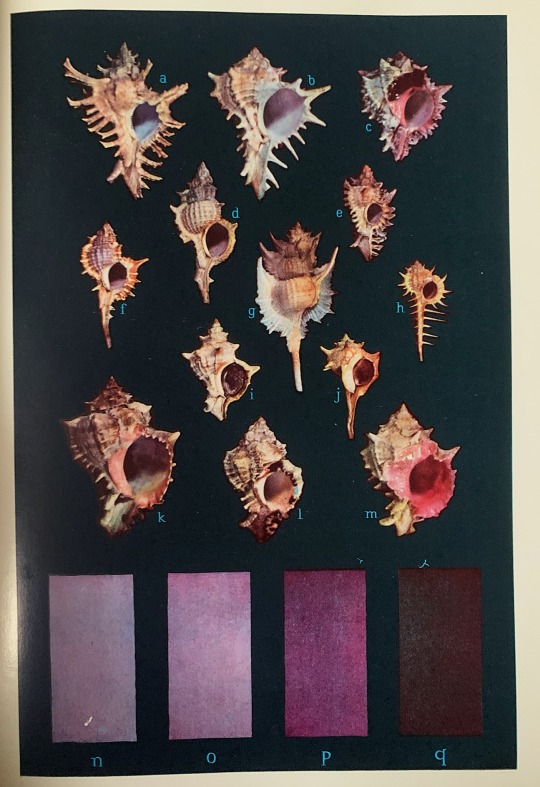

Left: Murex Shells and Royal Tyrian Purple
Right: Nerites, Purple-Sea Snails, and Sun-Dials
MS, R. Tucker A., and The New Illustrated Naturalist. 1954. ‘American Seashells’. 1st ed. Princeton, New
Jersey: D. Van Nostrand Company, Inc.
#seashells#sea life#deep sea#marine biodiversity#sea snail#evolutionarybiology#malacology#natural science#scientific illustration#collection#snailblr#biologyblr#endangered species#signal boost#paleoblr#entomology#evolution
20 notes
·
View notes
Text

//Something I haven't really brought to the blog as it originated in WoW RP, but now I'm not just canonizing it, I'm weaponizing it as well: Abena's own nerdy side.
She collects seashells. It started off as a beachside hobby of hers to get as many shells of different marine species as possible, mostly for the aesthetics and fun of it. But after being exposed to Josep's naturalist dreams, now she collects seashells with him as a joint hobby in studying them more in-depth, especially across the regions. Are the sand dollars in Jamaica any different from the ones in China? What is so different between the Queen Conch and the Australian Trumpet? Why would puka shells appear in certain sizes in some parts of the world and not others, or at all?
With all this said, there are two groups of seashells she collects, and she is very particular with how they are to be handled. One set of seashells are collected for the combined purpose of aesthetic and study, so they would be on display in the Captain's cabin or stored in delicately lined lockers.
The other set of shells is to be used as part of her potion-making with her Rotteness to the Bones. These shells are intended to either hold voices or parts of someone's soul (their hair, nails, etc). Think the seashell Ursula wore when in disguise in 'The Little Mermaid'.
If you are to ask her what her favorite shells are, they end to be the shells of Murex snails, which are those gorgeous conch shells with flared spines.
#[About Abena]#[Abena Frascona]#so yes she DOES go for walks on the beach with the husband#just for nerdy reasons as well as romantic lmao
5 notes
·
View notes
Link
Check out this listing I just added to my Poshmark closet: CABRITS MUREX Seashell.
0 notes
Text
Title: Exploring Seashell Types: A Guide to Coastal Treasures
Welcome to the fascinating world of seashells! In this exploration, we'll dive into the diversity of seashell types, uncovering the unique characteristics that make each one a coastal treasure. Whether you're a seasoned collector or a beachcomber discovering shells for the first time, join us on this journey to appreciate the intricate beauty and incredible variety of seashells.
Conch Shells: Echoes of the Ocean's Symphony
Conch shells, with their iconic spiral shape, are nature's trumpets. Learn about the different species, from the Queen Conch to the Horse Conch, and discover how these shells play a role in both marine ecosystems and human cultures.

Cowrie Shells: Timeless Elegance from the Sea Admire the timeless elegance of cowrie shells, prized by cultures throughout history for their use in jewelry and currency. Explore the various species and learn about the cultural significance attached to these polished, glossy gems of the ocean.
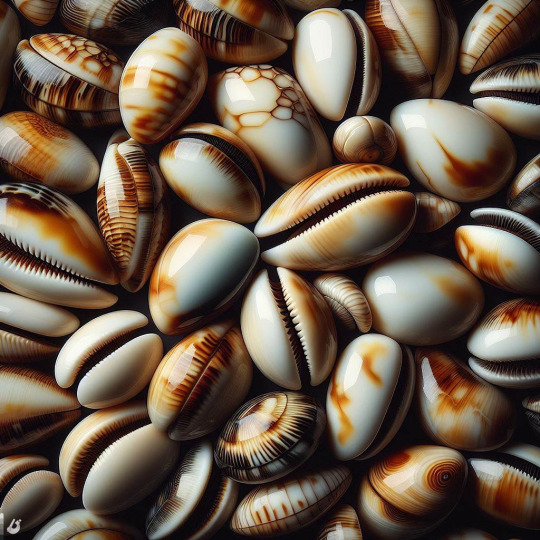
Scallop Shells: Nature's Perfect Fan
Delve into the intricate world of scallop shells, known for their fan-like ridges and delicate patterns. Discover the different types of scallops and how these shells are not only aesthetically pleasing but also have interesting functional adaptations.
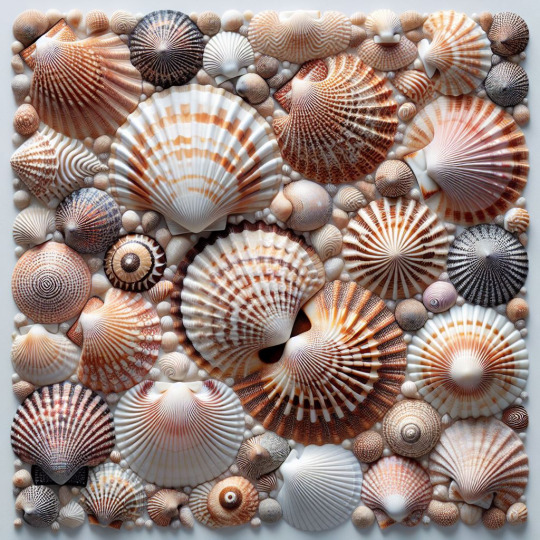
Auger Shells: Spirals of Underwater Art
Explore the mesmerizing spirals of auger shells, a diverse family with species ranging from the small and delicate to the large and striking. Learn about their role in marine ecosystems and how their intricate designs are a testament to the wonders of natural geometry.

Murex Shells: Sculptures of the Deep
Uncover the sculptural beauty of murex shells, characterized by spines, ridges, and intricate patterns. Dive into the world of predatory snails and learn how these shells play a crucial role in marine food chains.
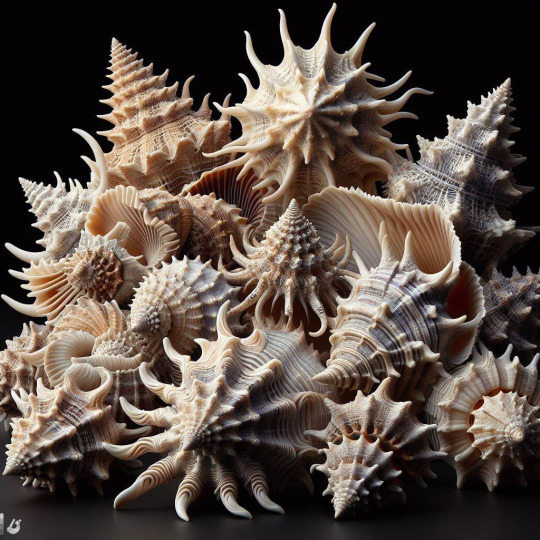
Seashells are not just remnants of marine life; they are unique works of art shaped by the sea. As you explore the different seashell types, you'll gain a deeper appreciation for the diversity of life beneath the waves. So, whether you're a collector, a beach enthusiast, or someone who simply enjoys the beauty of the ocean, let the world of seashells captivate your imagination.
#Seashells#ConchShells#CowrieShells#ScallopShells#AugerShells#MurexShells#ShellCollecting#MarineLife#OceanArt#BeachDiscoveries#NatureGuide#CoastalExploration#SeashellIdentification#UnderwaterBeauty#OceanTreasures
1 note
·
View note
Text
What's the Vibe? #11

I just wanted to write something for this week (well, more past 3 weeks), as a note for the blog which is something that only Internet many people are saying, so this idea wouldn’t be a new one.
The idea is that trends are dead, and that the idea of a trend forecaster is is not redundant, but has to be bigger than just fashion considering that everything everywhere is happening all at once for every sort of person we all have access to the Internet, we all have access to books and tools to make ourselves look the way we would want to look as long as the conditions we live within allows it. The reason why I’m so interested in politics, and other social events is because that this can predict moods and predict moods for the future, just like now there is like is "recession culture" that really I should be researching specifically for the UK considering that it is probably one of the only advanced nations within the G7 that is going to go through a recession.
OKAY. News:
Pharrell as the new Creative Director for Louis V Menswear!
Daniel Lee at Burberry - new logo - new show on the 26th?
Rihanna Loewe look for the Super Bowl - my prediction is JW Anderson exhibition at the V&A in less than 10 years? I say 5.
Paw patrol with these mules.
Aphex Twin summer???
Eater London is shuttering.
Beauty Moodboard for the week:






1 / 2 / 3 / 4 / 5 / 6
Things I'm obsessed with from AW23 Fashion Weeks:
Botter Bike Seat Bag + Car necklaces/rings


Botter x Reebok Shoes

"Coined the “Venus Comb Murex Shell” the sneaker uses a vintage Reebok Football silhouette as its core design whilst its unique form is inspired by the Murex seashell which in legend was used by the Greek Goddess Venus to comb her hair.
The Venus Comb Murex Shell was created and engineered with the HP 3D Printing team based in Barcelona using a process called HP Multi Jet Fusion Technology." - Highsnobiety
Collina Strada animal faces. Make up by Isamaya, photos by Soraya Zaman :




Sorry, I can't find hi-res for this but Head of State from NYFW! The shower looks cool - hopefully for the next one we can find some video content!

Martine Rose (in general)




Bianca Saunders



The Future of Balenciaga is on the Line - NYT
Who Is Rihanna, Really? - Teen Vogue
Holy Endeavours: An Interview with Filippo Sorcinelli - Tone Glow
0 notes
Text
Imperial Rome and Italy Superior
Imperial Rome and Italy Superior is a necessary post to explain the Venetian (Italian) influence of Florida, formally, called La floridas, which means the land of the flowers.
#foogallery-gallery-3108 .fg-image { width: 150px; } #foogallery-gallery-3108 .fg-image { width: 150px; }
Flag of Mexico
The current flag of Mexico features the red, white, and green colors of the Maurs, but this version of the Mexican flag features the Eagle (the phoenix) killing the serpent (Dragon), which symbolizes Rome’s (the Vatican’s) victory over the Saracens (Muurs) and pagans (Hebrews) for control over Granada Land/Promised land in the Americas
Roman Empire Philip the Arab, 204-249.
Imperial Rome and Italy Superior was in the Americas since I found an ancient Roman coin of Roman Emperor Philip I the Arab (Saracen) with the Imperial Roman Eagle on the reverse side of the coin with a serpent in its mouth. The flag of Mexico features the same exact Eagle of Rome with the serpent in its mouth, which suggests that the first Vatican City was in Mexico near Teotihuacan (see blog post, “Teotihuacan is the home of Thoth”). The fact that Philip I the Arab was born in Arabia leaves no doubt that the flag of Mexico is the Imperial Flag of Rome since Southern Arabia was in Mexico.
Scallop Seashells and Cobra shields.
Terra-cotta border around the entrance arch at ponce del Leon hotel with Scallop seashells and cobra shields that spell out the phrase, Ponce de Leon, which means House of Lion.
Scallop Seashells at the Ponce de Leon Hotel
Scallop seashells decorate the terra-cotta border around the main front entrance of the Ponce de Leon Hotel. The symbol of the Scallop Shell of Greco-Roman civilizations is a symbol of value (wealth) due to its association with the Murex shellfish (Purple fish) and fertility. Fertility is also the theme in what may be the best known pre-modern reference to the scallop shell: Sandro Botticelli's The Birth of Venus (1452). In that work, the scallop shell is associated with the Greek goddess Aphrodite and her Roman counterpart, Venus; Venus is symbolically born out of a shell (an egg).
Hotel Alcazar in St. Augustine, FL.
Cordova, Spain is famous for its Moorish Architecture such as the Alcazar. Likewise, Saint Augustine is famous for its Moorish revival architecture such as the Hotel Alcazar, now known as the Lightner Museum. Now, if we include Seville Street (as in Seville, Spain), in Saint Augustine, Florida, we can agree that Saint Augustine looks like Andalusia, Spain with all of these place names that are associated with the Moors of the Iberian Peninsula, which was located in La floridas according to my “Gibraltar of the West” blog post.
Saint Augustine of hippo
The city of Saint Augustine, Florida existed prior to the Spanish invasion of the 1500’s since the city is named after Roman Saint Augustine of Hippo, who was a Consul for Roman North Africa. Saint Augustine (13 November 354 – 28 August 430) was a Berber (Saracen) from North Africa that help to establish Christianity in the Western World
Ponce de Leon Hotel - Phoenician purple Room
Paintings of Venetian sail ships, Moormons (male mermaids), and mermaids decorate the walls. Speaking of the Phoenicians, the Ponce del Leon Hotel has a room trimmed in Cypress wood and with a Phoenician purple mural on the ceiling. Purple is the highest spectrum of light and it symbolizes the crown chakra, which is the most high god.
Ponce de Leon Hotel walkway
A lavish Ponce de Leon Hotel walkway with stained glass windows, and with wood trim made from Cypress wood.
The mosaic marble floor
The mosaic marble floor under the Rotunda at the Ponce de Leon Hotel
The Rotunda at the Ponce de Leon Hotel
The Rotunda is a representation of the 8-pointed flag of the Marinid Sultanate/ Dynasty. Some say it is also that of the Almohad Dynasty. Marinid is from the words Marine and Mariner, aka, the Sea People that were Moormons and Mermaids. Mer/ Mar is Latin for sea. The star on the Moorish red flag is called the Ogdoad or 8-pointed star, and it is a symbol of life, fertility, and wards against evil. It also is a Octagram. Octagrams are formed from overlapping squares which emphasize duality: yin and yang, male and female, spiritual and material. Squares are often connected with the physical world: four elements, four cardinal directions, etc. Together, they can mean both positive and negative aspects of the four elements, for example, balancing them to create harmony/ life.
The Flagler Room at Ponce de Leon Hotel
The ballroom now called the Flagler room has 12 Austrian Crystal chandeliers at the Ponce de Leon Hotel
Ponce de Leon Hotel Chandeliers
The ballroom now called the Flagler room has 12 Austrian Crystal chandeliers at the Ponce de Leon Hotel
Ponce de Leon Hotel - Water Fountain
One of several water fountains at the Ponce de Leon Hotel. This one is based off the cosmos since the ball or point at that top is the Pole Star or North Star. The four turtles below represent the four major cardinal points of the zodiac. The twelve turtles that surround those four turtles, represent the twelve signs of the zodiac which are also the 12 months of the year, and the 12 Apostles of Christ.
The Ponce de Leon Hotel - water fountain
The Ponce de Leon Hotel is one of the most extravagant and luxurious pieces of property in the world. It is located at 74 King Street and on the corner of Granada Street. This is a closeup view of one of the water fountains.
Ponce de Leon Hotel - Front View
The Ponce de Leon Hotel is one of the most extravagant and luxurious pieces of property in the world. It is located at 74 King Street and on the corner of Granada Street
Aerial view of Ponce de Leon Hotel
In this post are some aerial views of the Ponce de Leon hotel to show you how vast this Venetian Gothic Castle/ Mansion is.
Ponce de Leon hotel - Aerial view
In this post are some aerial views of the Ponce de Leon hotel to show you how vast this Venetian Gothic Castle/ Mansion is
Ponce de Leon Green Dragon stem vents
The two landing towers in the blimp image also serve as hydro-electric towers/ generators that supplied free hydro-electric energy (free Energy) generated from steam (water), since one tower is the anode (the male or positive charge from the hot water that it stored) and the other tower is the cathode (the female or negative charge from the cold water that it stored). More evidence of free energy is the Ponce de Leon green steam dragons that once served as high pressure release valves to release hot steam (fire) from the structure when the lights were turned on (see post image of green steam dragon). These green steam dragons had a red-light bulb in their mouths to resemble fire breathing dragons when the power was turned on during the nighttime.
Landing platform for blimp - Tartary
This colorized image from late 1800's of a blimp in New York City that is anchored to a skyscraper’s landing tower. This image is a perfect example of how Moorish Nobles would make their grand entrance into these old-world structures.
Landing platform for blimp - Tartary
This colorized image from late 1800's of a blimp in New York City that is anchored to a skyscraper’s landing tower. This image is a perfect example of how Moorish Nobles would make their grand entrance into these old-world structures. You can see several other blimps in the background too.
Ponce de Leon Hotel landing platform.
Colorized image from the late 1800’s of a blimp getting ready to land on one of the two landing platforms (towers) to choose from at the Ponce de Leon Hotel. The blimp anchors to one of the towers and a landing bridge comes out to connect the blimp with the tower so that the flight attendants on the blimp could make a grand entrance into this fabulous Venetian Gothic Castle, known as the ponce de Leon Hotel (see post images of a blimp anchored to the skyscraper’s tower for an example).
Ponce De Leon Hotel in the late 1800's
Throwback image from the late 1800’s of the front entrance of the Ponce de Leon Hotel shows you a medieval-style castle draw bridge or gate with two pillars of Tartarian red brick masonry that are decorated with the face of a Medici Lion on each pillar of masonry, so yes..., Ponce de Leon means the House of the Lion, based upon the evidence. This lion is called Marzocco (Morocco*?) and is a symbol of protection for the city of Florence, Italy, aka, the Free Republic of Florence against the Imperial Eagle of Rome
Medici Lion in Saint Augustine, FL.
Medici Lion at the Bridge of Lions in Saint Augustine. This lion is called Marzocco (Morocco*?) and is a symbol of protection for the city of Florence, Italy, aka, the Free Republic of Florence, Italy against the imperial Eagle of Rome.
Alessandro de' Medici, the Moor
Alessandro de' Medici (22 July 1510 – 6 January 1537), nicknamed "il Moro" due to his dark complexion, Duke of Penne and the first Duke of the Florentine Republic (from 1532), was ruler of Florence from 1530 to his death in 1537. The first Medici to rule Florence as a hereditary monarch, Alessandro was also the last Medici from the senior line of the family to lead the city. His assassination at the hands of distant cousin Lorenzaccio caused the title of Duke to pass to Cosimo I de Medici, from the family's junior branch. There were several Pope's in his family, one of them was Pope Leo XI
The red flag of the Mayan Moors. These Mayans established Florida after their homeland Atlantis in Mexico had sunk.
Phoenician Mayan Moor with Dredd locks and with a red flag in his hand.
Phoenician Bust
This is a Phoenician Bust of a Blackamoor. Yes, the Phoenicians were Negroes/ Nagas, aka, Black people.
Venice in West Palm Beach
Whitehall was initially the Whitehall Hotel with a Moorish red roof (see post image), but now it is called the Whitehall Museum. This building even has a small train station attached to it that is made from copper and it has an old train inside of the station
Whitehall Museum on the water
Whitehall was initially the Whitehall Hotel with a Moorish red roof (see post image), but now it is called the Whitehall Museum. This building even has a small train station attached to it that is made from copper and it has an old train inside of the station
Whitehall Museum
Whitehall was initially the Whitehall Hotel with a Moorish red roof (see post image), but now it is called the Whitehall Museum. This building even has a small train station attached to it that is made from copper and it has an old train inside of the station
Inside Kapok Tree Restaurant
Inside Kapok Tree Restaurant
Inside the Kapok Tree inn Restaurant
Inside the Kapok Tree inn Restaurant
The Kapok Tree Inn
The inside of Kapok Tree Inn Restaurant
Inside of the Kapok Tree Inn
Inside of the Kapok Tree Inn
The Kapok Tree Inn Garden
The Kapok Tree Inn Garden
Two Medici Lions at entrance of Kapok Tree Inn
These two lions are known as the Medici Lions because they once belonged to Grand Duke Ferdinando I de’ Medici and adorned Villa Medici, his home in Rome, until they were moved to Loggia in 1789. This lion is called Marzocco (Morrocco*?) and is a symbol of protection for the city of Florence, Italy, aka, the Free Republic of Florence against the imperial Eagle of Rome. The heraldic lion—also known as the Marzocco lion—is the animal symbol representing the free Republic of Florence. As the legend goes, the Florentine Republic chose the symbol of the lion over other animals because lions can tear apart the eagle, which is the symbol of imperial power
The Kapok Tree Inn Italian Gardens
The Kapok Tree Inn Italian Gardens. A taste of old world Florida dinnning
The Kapok Tree Inn Water Fountains
The Kapok Tree Inn Water Fountains
The Kapok Tree Inn
The Kapok Tree Inn, a taste of Italy
The Venetians are named after their city Venice, Italy, which is a city built around water with a serious of water canals. Likewise, Florida is a state with thousands of water canals similar to the ones in Venice, Italy. Venice was established by those Phoenician Moors that conquered the Iberian Peninsula, Spain, Italy, etc., which explains why Venice is a water canal city since the Moors as mariners were sea people (see image of Phoenician Maur); and this also explains the Moorish/ Tartarian architecture found all throughout Venice, Italy.
The Phoenicians were initially the Naga-Maya (Mayans) that civilized the world after their home Teotihuacan (the capital of Atlantis) had sunk (see blog post, “Teotihuacan is the home of Thoth). In addition, the Phoenicians are also from the Americas: https://www.americaistheoldworld.com/the-phoenicians-are-from-the-americas/.
These Naga-Maya (Phoenicians/ Atlanteans/ Egyptians) came to Florida and built the Moorish/ Tartarian architecture throughout Florida: https://www.americaistheoldworld.com/gibraltar-of-the-west/.
In this post are images of the Kapok Tree Inn and its exotic Italian (Venetian) restaurant, which is located around the Sam Ash Music Store, in Clearwater, Florida, near Tampa Bay (Bey) and by the Bay bridge. The Venetian Gothic Architecture (Moorish or Tartarian Architecture) is amazing. Imagine how this place looked like in her prime! The Kapok Tree is the Sacred Tree of the Aztecs (Atlanteans) and Mayans (Egyptians), so yes…, Phoenician Mayans (Moors/ Tartars) built this. This place has two Medici lions at its entrance, which are a symbol of Florence, Italy.
The city of Florence was established by Julius Caesar, around 59 BC, as a settlement for his veteran soldiers and was named originally Fluentia, because it was built between two rivers, which was later changed to Florentia (“flowering”). Florentia sounds a lot like Florida, which also means Flowers or the land of flowers. In 1513, Spanish explorer Juan Ponce de Leon named the state La Florida – “Land of Flowers” – for the Easter season in which he made his discovery.
Italy and Florida and both shaped like boots:
Also, Florida and Italy are both shaped like boots, and they are both Peninsula’s. The only difference is that Florida is shaped like an upside-down boot. We know that Rome is in Italy, so Florida being shaped like the Country of Italy suggests that the original Italy was in the Americas, which equates to the original Rome being in the Americas by default since Rome is in Italy.
Additionally, Italy and Florida share some of the same city place names, such as: Naples, Venice, Florence, and Milan. We can also Include Rome, Georgia, since Florida is attached to Georgia and Florida used to be a huge territory of land called La Floridas (Tameri), which included Georgia, most of North America, and some parts of Canada and Mexico. Georgia also has a Milan and a Florence.
Yes, the European Italy (Rome) was patterned after greater Italy or Italy Superior that was called La floridas. I say this because Ancient Rome and Greece was in the Americas: https://www.americaistheoldworld.com/ancient-greece-and…/.
Additionally, the first Vatican City was in Mexico near the Capital of Atlantis, which was Teotihuacan: https://www.americaistheoldworld.com/teotihuacan-is-the…/.
Alessandro de’ Medici (22 July 1510 – 6 January 1537), nicknamed “il Moro” (the Moor) due to his dark complexion, Duke of Penne and the first Duke of the Florentine Republic (from 1532), was ruler of Florence from 1530 to his death in 1537. He was the first Medici to rule Florence as a hereditary monarch, Alessandro was also the last Medici from the senior line of the family to lead the city. His assassination at the hands of distant cousin Lorenzaccio caused the title of Duke to pass to Cosimo I de Medici, from the family’s junior branch.
The Medici family was very powerful in medieval history, since there were several Pope’s in the Medici family, one of them was Pope Leo XI. Pope Leo XI (Italian: Leone XI; 2 June 1535 – 27 April 1605), born Alessandro Ottaviano de’ Medici, was head of the Catholic Church and ruler of the Papal States from 1 April 1605 to his death.[1] His pontificate is one of the briefest in history, having lasted under a month. He was from the prominent House of Medici originating from Florence.[2]
The Medici family resigned from the Papal States, due to infighting stemming from this family not wanting to be a part of the now corrupted Papal States. However, when you are a part of an organized gang (the Vatican) you can’t just leave without war/ fighting, hence the ole true saying, “Once you are in you can’t get out.”
As a result of the conflict between the Medici’s and the Vatican, the Medici’s created the Medici lion. This lion is known as the Medici Lion because it once belonged to Grand Duke Ferdinando I de’ Medici and adorned Villa Medici, his home in Rome, until they were moved to Loggia in 1789. This lion is called Marzocco (Morocco*?) and is a symbol of protection for the city of Florence, Italy, aka, the Free Republic of Florence, Italy against the imperial Eagle of Rome.
The heraldic lion is the animal symbol representing the free Republic of Florence. As the legend goes, the Florentine Republic chose the symbol of the lion over other animals because lions can tear apart the Imperial eagle of Rome, which is the symbol of imperial power: https://www.florenceinferno.com/marzocco-symbol-of-florence/.
Two Medici Lions at the Whitehall Hotel:
In addition, at Whitehall in West Palm Beach, Florida, the Home of Robber Baron, “Henry Morisson Flagler,” there is a fabulous Venetian (Phoenician) mansion by the water that also has two Medici Lions at the front entrance with a giant Kapok Tree of the Mayans on the property: https://www.youtube.com/watch?v=shNollkkukQ&t=10s. The middle name of Flagler is Morisson and it means “son of the Moor.” Could Flagler really be the son of a Moor or the conqueror of the Moors since he claimed towns and properties that belonged to the Moors? It was a little bit of both.
Whitehall was initially the Whitehall Hotel with a Moorish red roof (see post image), but now it is called the Whitehall Museum. This building even has a small train station attached to it that is made from copper and it has an old train inside of the station (see post images).
The Lion Gate Bridge:
We must also consider the Lion Gate Bridge in Saint Augustine Florida since it is also Venetian Gothic Architecture. This bridge has a Medici Lion named Marzocco at the entrance of the Lion Gate (see post image), which leads directly to the House of the Lion, which translates in Spanish as “Ponce de Leon.” Ponce de Leon is now part of Flagler College. The flag of Flagler College is a red crest or shield with a golden Medici Lion on it, which supports the fact that Ponce de Leon means, “House of the Lion.”
In addition, here is a throwback image from the late 1800’s of the front entrance of the Ponce de Leon Hotel shows you a medieval-style castle draw bridge or gate with two pillars of Tartarian red brick masonry that are decorated with the face of a Medici Lion on each pillar of masonry, so yes…, Ponce de Leon means the House of the Lion, based upon the evidence. This lion is called Marzocco (Morocco*?) and is a symbol of protection for the city of Florence, Italy, aka, the Free Republic of Florence against the Imperial Eagle of Rome.
Saint Augustine, Florida is oldest city in America allegedly founded in 1565 by a Spanish admiral, which is 40 years older than the founding of Jamestown Virginia. St. Augustine is the oldest continuously occupied European settlement in the continental U.S. Tourist attractions include two national monuments that are sites of old Spanish forts: Castillo de San Marcos and Fort Matanzas.
The city is also known for its spectacular Moorish Revival and Spanish Renaissance Revival buildings from the late 19th century. These include the former Hotel Alcazar and Ponce de Leon Hotel, both built by industrialist Henry Flagler. The Alcazar now houses St. Augustine City Hall and the Lightner Museum, which is known for its collection of 19th century fine and decorative art. The Ponce de Leon is now part of Flagler College.
The Ponce de Leon Hotel:
The Ponce de Leon Hotel is one of the most extravagant and luxurious pieces of property in the world. It is located at 74 King Street and on the corner of Granada Street. Wow, what a location since King means sovereign ruler and Granada is Spanish for the pomegranate fruit, which is a symbol of the Promised Land of Jerusalem, when this fruit is fully bloomed, since it resembles the shape of the 6-pointed Star of David. Yes, Granada Land (the promised land) was in the Americas, and it covered La Floridas, parts of Canada, Mexico, Central America, and South America: https://www.americaistheoldworld.com/granada-land-is-the-promised-land-of-israel/.
According to the Torah (Old Testament of the Bible), Jewish tradition teaches that the pomegranate is a symbol for righteousness because it is said to have 613 seeds that corresponds with the 613 mitzvot or commandments of the Torah. In some artistic depictions, the pomegranate is found in the hand of Mary, mother of Jesus.
The pomegranate plant arrived in Rome via Carthage, which explains why the ancient Romans referred to pomegranate fruits as ‘apples of Carthage’ (Tunis=Tennessee). The people of Carthage were a branch of the Phoenicians. Pomegranate is known in Egyptian Hieroglyphics as “Ramen.” In Hebrew Rimon, means pomegranate. Both Ramen and Rimon are the origin of the term Roman, which means Promised Land.
Florida also has a Granada in Sarasota, Florida. Granada was a stronghold for the Moors of Spanish Iberia. However, the original Iberian Peninsula and Hispaniola (Spain) was in La Floridas, which was a huge territory of land once. Please refer to the above blog post, “Gibraltar of the West,” for evidence on this. Now that we know the significance of Granada let’s look at some of the images of the Ponce de Leon Hotel.
The Venetians/ Phoenicians were a highly Advanced Nation of people with Flying Machines and Free Energy Technology:
In this post is a colorized image from the late 1800’s of a blimp getting ready to land on one of the two landing platforms (towers) to choose from at the Ponce de Leon Hotel. The blimp anchors to one of the towers and a landing bridge comes out to connect the blimp with the tower so that the flight attendants on the blimp could make a grand entrance into this fabulous Venetian Gothic Castle, known as the ponce de Leon Hotel (see post images of a blimp anchored to the skyscraper’s tower for an example).
The two towers in the blimp image also serve as hydro-electric towers/ generators that supplied free hydro-electric energy (free Energy) generated from steam (water), since one tower is the anode (the male or positive charge from the hot water that it stored) and the other tower is the cathode (the female or negative charge from the cold water that it stored).
More evidence of free energy is the Ponce de Leon green steam dragons that once served as high pressure release valves to release hot steam (fire) from the structure when the lights were turned on (see post image of green steam dragon). These green steam dragons had a red-light bulb in their mouths to resemble fire breathing dragons when the power was turned on during the nighttime.
In this post are some aerial views of the Ponce de Leon hotel to show you how vast this Venetian Gothic Castle/ Mansion is. The main entrance room of the Ponce de Leon Hotel features an 8-pointed rotunda on the ceiling with a polished marble mosaic floor. The ceilings are decorated with remarkable mural paintings, which have been whitewashed. The ballroom now called the Flagler room has 12 Austrian Crystal chandeliers.
The inside is immaculate since all the wood inside is made of Cypress wood. Cypress wood is the second most expensive wood in the world, because it is fire resistant, bug resistant, water resistant, and rot resistant. Cypress wood can last forever, and its oil or resin has medicinal healing properties.
The Phoenicians (Venetians), the Biblical Canaanites (Kushites), as sea people (mariners =maur-iners) built their ships out of Cypress wood and so did the Florida Barbery Pirates (Barbery =Tartary) since Cypress wood is the best wood in the world for building boats due to the said benefits given above, plus the wood will not rot in water since bald Cypress grows in water and it repeals water which helps the ship cut through the water.
Paintings of Venetian sail ships, Moormons (male mermaids), and mermaids decorate the walls. Speaking of the Phoenicians, the Ponce del Leon Hotel has a room trimmed in Cypress wood and with a Phoenician purple mural on the ceiling. Purple is the highest spectrum of light and it symbolizes the crown chakra, which is the most high god.
The Phoenicians are legends of the ancient sea trade, and they were your first merchants (Maur-chants) with the merchandise (Maur-chandise) since they were masters of the seven seas and developed some of the first languages to effectively trade with each other and with other nations. Bits and pieces of their language and influence can be found in all four corners of the earth. One trade they are famous for is that of the color of Tyrian (Royal) Purple. Color was a symbol of status in the Old World. Purple was considered the color of royalty by people such as the Roman’s and Byzantine Empire. In fact, one born of royal blood would be called “Born in the Purple.” Some historians believe the name Phoenicia means “Land of Purple.”
The method of extraction is tedious. One has to take a specific Murex Shellfish and extract its mucus, which killed them. It would take thousands of Murex shellfish just to create an ounce or so of dye. Which made the Royal dye more valuable than gold. On top of that, Tyrian Purple lasts much longer than most other dyes.
Beyond the Mediterranean (the Gulf of Mexico), there are a number of other sea snails useful for dyeing. Some 140 species flourish off the shores of North and South America. Of these, Purpura patula, Purpura persica and Purpura aperta inhabit the Gulf of Mexico, and these are still valued today in Central America, where women use them to color skeins of yarn. Sun and saltwater cause the pigment to oxidize on the fibers into an attractive but uneven purple. Unlike the Mediterranean types of murex, which must be crushed to obtain the tiny sac of pigment, the gland on the American shellfish is closer to the surface, and the creature can be persuaded to squirt its secretion onto the yarn. Afterward, the shellfish can be put back into the sea, given time to recover, and used again. Threads colored in this way tend to retain a fishy smell, however. The dyes in many pre-Columbian textiles and the purple paint in the Nahuatl codices have been analyzed and found to be shellfish purple.
The name “Phoenician”—and “phoenix,” the legendary bird reborn in the flames— is derived from the Greek phoinix, meaning “purple-red.” (Murex comes to us from Latin, derived from the Greek muax, or “purple fish.”) It was the Phoenicians who developed and promoted the Mediterranean murex market.
Now that we have seen how grand the Ponce del Leon Hotel is. It is no way possible that Henry Flagler could have built this Hotel and several other Venetian Gothic Structures in Saint Augustine and throughout Florida in the late 1800’s (1888), since these structures were built with a special coquina mix, which predates Henry Flagler by far since Castillo de San Marcos, a Tartarian star fort, in Saint Augustine was built 300 years prior to Henry Flagler using the same coquina mix and so was most of the city of Saint Augustine.
In addition, the city of Saint Augustine, Florida existed prior to the Spanish invasion of the 1500’s since the city is named after Roman Saint Augustine of Hippo, who was a Consul for Roman North Africa. Saint Augustine (13 November 354 – 28 August 430) was a Berber (Saracen) from North Africa that help to establish Christianity in the Western World: https://en.wikipedia.org/wiki/Augustine_of_Hippo.
Saint Augustine is from the 300’s A.D., and a painting of him is in this post posing in front of Venetian Gothic and Greco-Roman Architecture. These old-world Structures are a lot older than we think, based upon the evidence, so it is no way possible that Henry Morisson Flagler (son of a Moor) could have built these old-world structures since the evidence suggests they were already here.
Saint Monica, the mother of Saint Augustine, was also from Saint Augustine, Florida since her house, “Casa Monica,” still exists and was renamed Cordova Hotel by Henry Flagler in 1888. Casa Monica is Spanish for House of Monica. The name Cordova is interesting since Cordova was once a Roman territory and is third largest city in Andalusia, Spain.
Cordova, Spain is famous for its Moorish Architecture such as Alcazar. Likewise, Saint Augustine is famous for its Moorish revival architecture such as the Hotel Alcazar, now known as the Lightner Museum. Now, if we include Seville Street (as in Seville, Spain), in Saint Augustine, Florida, we can agree that Saint Augustine looks like Andalusia, Spain with all of these place names that are associated with the Moors of the Iberian Peninsula, which was located in La floridas according to my “Gibraltar of the West” blog post.
The Cordova Hotel and the Hotel Alcazar are both white with a red Moorish roof for each structure, and they are both Venetian Gothic Structures. These structures were also built using a special coquina mixture of shells that does exist anymore. Wikipedia calls this architectural style, “Moorish revival architecture”: https://en.wikipedia.org/wiki/Casa_Monica_Hotel.
Also, Saint Augustine was established by the first natives of Florida, the Timucuan Indians, so I highly doubt that Henry Flagler built these old-world structures in Saint Augustine and throughout Florida, since the evidence suggests that a previous advanced civilization of Maurs or Ethiopians (Atlanteans, Egyptians, or Tartars) built these structures. The Timucuan Indians were the Tamerikhans of Abyssinia/ Ethiopia Superior/ India Superior (Tameri or Moorenland: the land of the Maurs) in La Floridas: https://www.americaistheoldworld.com/timucuan-indians-are-the-tamerikhans/.
Saint Augustine Florida was part of Ancient Nineveh, since Saint Augustine is only 30 miles from Jacksonville, Florida, which was ancient Nineveh; therefore, these Moorish structures existed prior to Henery Flagler and the year 1888: https://www.americaistheoldworld.com/nineveh-was-jacksonville-florida/.
Saint Augustine Florida is home to Prester John’s (Saint John’s) Fountain of Youth in Ethiopia Superior, aka, La Floridas (Tameri). Nineveh means place of fish or fish in a house (the torus field). Prophet Jonah (John or Ion) of the Bible was from Nineveh since he was a fisher of men or a fisher king (High priest of Anu/ On) that was swallowed by the House of the dragon (Dagon/ Dogon priest). The whale symbolizes the dragon (everlasting life/ light), which use to be a symbol of free energy and the Christ before the dragon was made to appear evil to hide this knowledge from the masses.
Due to Nineveh being the House of the fish, Florida was home to quite a few fishers of men or Magi’s/ magicians, aka, saints (high priest of Anu), since they were all Baptized in the Fountain of Youth by their Patron Saint, Saint John the Baptist, aka, Prester John who was also the Biblical King David, Thoth, Melchizedek, etc. Even Saint Petersburg, Florida was named after Apostle Saint Peter, the first Pope and the blood brother of the first Apostle Saint Andrew. Saint Andrew was a Saracen/ Moslem (old Arab) and so was Jesus, King David, Mother Mary, and the 12 Apostles of Christ. Christianity was established by Saracens: https://rb.gy/piuetn.
The city of Saint Augustine was in Timucuan Territory and “an archaeological dig in St. Augustine in 2006 revealed a Timucuan site dating back to between 1100 and 1300 AD, predating the European founding of the city by more than two centuries. Included in the discovery were pottery, with pieces from the Macon, Georgia area, indicating an expansive trade network; and two human skeletons. It is the oldest archaeological site in the city.[8]” [end quote from: https://en.wikipedia.org/wiki/Timucua].
The Seashell was the key to wealth and Eternal Architecture:
The seashell was the key to wealth and eternal architecture that can withstand the test of time. The Phoenician Maurs (Moors) were sea people, so their way of life was derived from the sea, including their electricity, their commercial shipping, their shell concrete (coquina); and their purple dye for clothing, all made them wealthy. Fort Castillo, a Tartarian star fort, in Saint Augustine, Florida, is a good example of eternal Architecture, since this fort has survived several invasions or wars and it still stands today. This fort is cannon ball proof due to the special coquina shell mixture.
Fort Castillo’s masonry, or stonework, is mostly composed of coquina (Spanish for “small shells”) — a natural concrete derived from the ocean. Coquina is a rare form of limestone composed of the shell fragments of ancient mollusks and other marine invertebrates, which, over time, are glued together by dissolved calcium carbonate in the shells. Coquina is also the name of a common tiny clam found everywhere on Florida beaches. Their shells, which come in countless colors, are reflected in the Castillo’s muted hues.
As a building material, coquina is lightweight, easy to find (it’s indigenous to the Florida coast), easy to use, and nearly indestructible. Not only is coquina bullet-proof, but it is also virtually cannon-ball- proof! Due to its plentiful microscopic air pockets, coquina is easily compressed. In days long past, cannon balls fired at the Castillo simply lodged in its walls. Which, one supposes, is why the old fort still stands after 300 years. This also explains why these old-world Gothic and Greco-Roman structures have withstood the test of time, since they were built using an ancient form of concrete that doesn’t exist anymore.
A related building material is tabby, often called coastal concrete, which is basically manmade coquina. Tabby is composed of lime from burned oyster shells mixed with sand, water, ash, and other shells.
Speaking of shells, scallop seashells decorate the terra-cotta border around the main front entrance of the Ponce de Leon Hotel with Cobra shields underneath them with letters on each shield that spell out the phrase, “Ponce de Leon,” which means the “House of Lion.”
The symbol of the Scallop Shell of Greco-Roman civilizations is a symbol of value (wealth) due to its association with the Murex shellfish (Purple fish) and fertility. Fertility is also the theme in what may be the best known pre-modern reference to the scallop shell: Sandro Botticelli’s The Birth of Venus (1452). In that work, the scallop shell is associated with the Greek goddess Aphrodite and her Roman counterpart, Venus; Venus is symbolically born out of a shell (an egg).
Since La Floridas was Italy Superior (Rome) could the scallop shell really be the coquina shell? Yes, since the scallop shell and the Coquina shell look almost identical to each other. The only real difference between the two of them is the size of the shell. The old world had a huge reverence for the seashell since it was used to build a better way of life through commerce (high end purple products) and through eternal architecture, due to a special seashell concrete mixture that can last forever.
Some earthen floors have been found to contain crushed murex shells as aggregate for concrete—an example of recycling from about 1500 BC. More examples of recycling or repurposing of these seashells are the early mounds and pyramids in the Americas that were built out of seashells.
Considering all of the above evidence, I know you are asking yourself could the original Rome and Greece be in the Americas? The answer is yes…, the original Rome and Greece was in the Americas: https://www.americaistheoldworld.com/ancient-greece-and-ancient-rome-was-in-old-world-america/.
The above blog post demonstrates this fact by giving you 13 Capitoline Wolf Statues of Romulus and Remus suckling on the She Wolf that were found in the Americas. The Capitoline Wolf is a symbol of the founding of the city of Rome and the Roman Kingdom.
Rome was founded by Turks (Moors or Tartars), since the symbol of the founding of Rome is the statue of Capitoline wolf suckling Remus and Romulus. The wolf is a sacred symbol of the Turks, and it traces back to the dragon. Places like Cordoba, Spain is derived from the Turkish words Kurt (wolf) and Oba (home): https://www.facebook.com/Americaisthetrueoldworld/posts/4698605806870349. The Anatolians that did not like to use the term Turk, which is short for the name of their country, Turkey, referred to themselves as Rumi, which is Turkish for Rome.
Further evidence that Imperial Rome and Italy Superior was in the Americas is the existence of an 8th Century Roman Jewish Colony called Calalus (Cibola). Calalus was near Missouri, and it means promised land: https://rb.gy/uthtxh.
Imperial Rome and Italy Superior was in the Americas since the original Vatican City was in Mexico and the state flag of Mexico is the same as the Imperial Roman Flag:
Imperial Rome and Italy Superior was in the Americas since I found an ancient Roman coin of Roman Emperor Philip I the Arab (Saracen) with the Imperial Roman Eagle on the reverse side of the coin with a serpent in its mouth. The flag of Mexico features the same exact Eagle of Rome with the serpent in its mouth, which suggests that the first Vatican City was in Mexico near Teotihuacan (see blog post, “Teotihuacan is the home of Thoth”).
The fact that Philip I the Arab was born in Arabia leaves no doubt that the flag of Mexico is the Imperial Flag of Rome since Southern Arabia was in Mexico: https://www.americaistheoldworld.com/the-ottoman-empire-in-the-americas/.
Philip I the Arab was Roman emperor from 244 to 249. He was born in Arabia in 204 A.D. He is regarded by some scholars as the first Christian Emperor of Rome: https://en.wikipedia.org/wiki/Philip_the_Arab.
The Flag of Mexico is a symbol of transformation through Alchemy since it features the Imperial Eagle of Rome that is raising up the serpent in its mouth to give the serpent wings so that the serpent can become a dragon, which is a better version of itself.
According to the ancient coins of Imperial Rome, you had several Roman Emperors that were old Arabs (Saracens) and some of these coins feature the same exact Imperial Eagle of Rome lifting the serpent up with its mouth: https://www.coinshome.net/en/view-coins-collection.htm?id=Vi8KbzbiU3gAAAFNne7Si8HX.
In the past Rome was a righteous global Empire ruled by Saracens since the Maurs had an Eden style of government before it was corrupted. However, the duplicate Rome in Italy become corrupted due to envy and greed, and they decided that they were going to used religion to demonize the Saracens (Moslems) and pagans (Hebrews) of the Americas so that they could look humane and civil in the process of conquering the promised land and taking her resources.
Based upon all the overwhelming evidence in this blog post, Imperial Rome and Italy superior was in the Americas. If you learnt anything and you want to help me out with the cost of research and travel, please donate to my Cashapp at $Amunhotep7. Thank you for your time and enjoy. Peace.
The post Imperial Rome and Italy Superior appeared first on America is the Old World.
source https://www.americaistheoldworld.com/imperial-rome-and-italy-superior/?utm_source=rss&utm_medium=rss&utm_campaign=imperial-rome-and-italy-superior
1 note
·
View note
Text
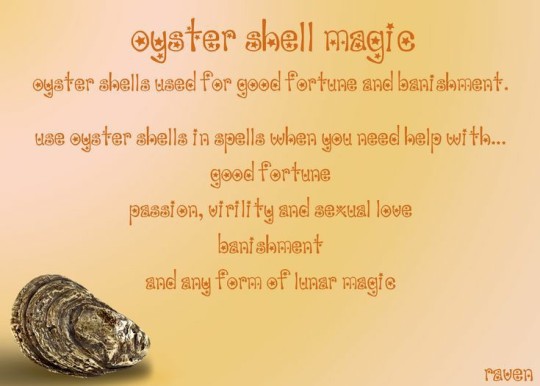









Seashells magical correspondences
#oyster#urchin#nautilus#clam shell#murex#moon snail#limpet#cowrieshell#sea witch#ocean witch#water witch#moon witch#seashells magical correspondences#book of shadows#mediterranean witch#cone shell#conch shell
125 notes
·
View notes
Text


finds of the day
01/28/22
#seashells#coral#oceanlife#beach day#shelling#seacore#photography#beach photography#nature#shells#ocean life#sharks eye#apple murex#lightning welk#banded tulip#fantasize
65 notes
·
View notes
Note
Hello there mr serpent! Do you have any favorite kind of seashells? Is there any shell you always wanted?
Favorites.. hm..
I like murex shells more than others, does that count..? And, i dont have a lot of whelk shells, they’re always so interesting to look at…
2 notes
·
View notes
Text
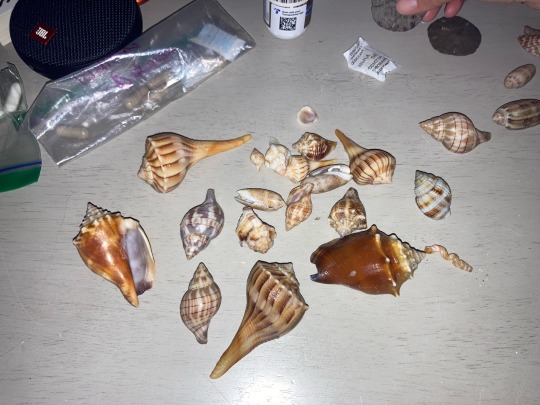
Behold the blessings of Poseidon 💙
This is all from ONE shelling venture! I’ve never found this many amazing shells at once. After a storm is the best time to go shelling — I should really be thanking Zeus and Poseidon. Also, one of the most stunning skies I’ve ever seen! Orange-lit clouds on one end, rainbow descending into the sea on the other.
#seashells#shells#sanibel#sanibel island#Florida fighting conch#lightning whelk#banded tulip#olive shell#apple murex#scotch bonnet#blessings#hail Poseidon
9 notes
·
View notes